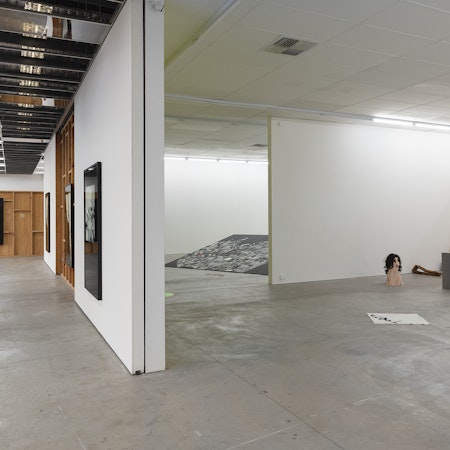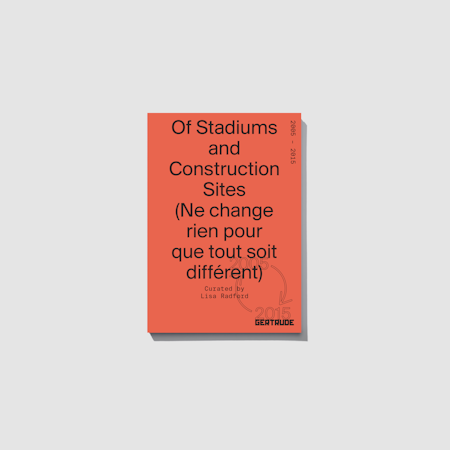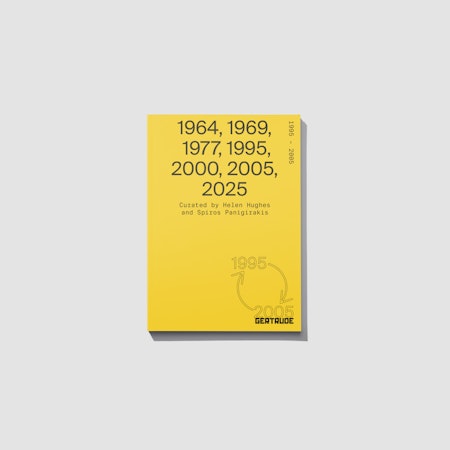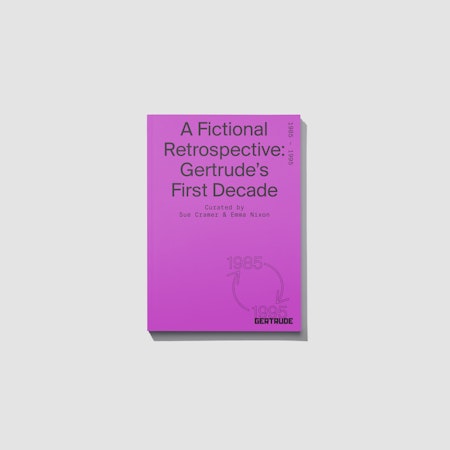Over a couple of evenings at home, I merged two phone books (the Yellow Pages, A-K and L-Z), overlapping them page by page to create one uneven and unusable volume. This act was to recreate—with permission—Phonebook (2008), a sculpture by artist Hao Guo for exhibition at the National Gallery of Victoria’s Melbourne Now over the summer of 2013–14.
It is funny where art ends up. Hao’s original phone book sculpture had been put together and taken apart in a pair of video performances. Although there might have been a few versions of Phonebook made for different exhibitions in 2008-09, Hao was back in Beijing by now and the work couldn’t be tracked down. So, Hao told me how to make it. The hardest part was finding a physical copy of the all but obsolete Yellow Pages. Hao wrote:
The process of joining the books was clumsy and slow,
with mistakes to begin with, but with practice, developed
rhythmically, becoming a machine-like process, and
eventually the body, via muscle memory, enters a new
conscious zone. […] Every page constitutes a step to
complete and deciding the position of the next page.
Who said action needs consciousness? It only needs the
will to participate and start.¹
Friction between each page holds the two books together, such that once interlocked they cannot be separated by pulling at the ends, but only by unfolding one leaf at a time. Thousands of thin, flimsy pages hold firmly together in this new shape.
Phonebook was shown in Objects in Space, a group exhibition held across multiple venues during the 2008 Next Wave Festival, and in The (self initiated, artist funded) Second (Fourth) Y2K Melbourne Biennial of Art (& Design) at TCB Art Inc., also in 2008. Later, Hao exhibited video works depicting in real time the making and unmaking of Phonebook for his solo exhibition ITISHAPPENING at West Space in 2009. In one video, Hao is shown piecing the two phone books together over several hours. In a second video the phone books are tediously peeled apart by someone else, completely undoing Hao’s attempt to solidify the two. At the time I wrote: ‘like many of Hao’s works, we’re not sure if this is a tragedy or a comedy’.²
It is funny where art ends up. I’ve seen artists purge swathes of work into rubbish dumps or op shops when clearing out storage units and studio spaces. I’ve heard about years’ worth of artists’ archives going missing. At times, I’ve housed artworks and the archives of small arts organisations in my home, and almost lost pieces in the chaos of sharehouse living.
I was in a cold sweat for a day when I couldn’t immediately find a work Hao Guo and A Constructed World (ACW) had made together – a collaborative sculpture that incorporated a poster tube, a gauzy spinning money tree decoration purchased in Richmond, and a text. The work, Money tree (2006), had wound up at my flat after an exhibition at Victoria Park Gallery, and a year later was called up to be included in ACW’s major survey exhibition at the Australian Centre for Contemporary Art, titled Increase Your Uncertainty (2007). The unassuming object must have been moved around by my housemate and thankfully revealed itself perched on top of a bookshelf in the back lean-to room. (All this during a period often described as ushering in the professionalisation of contemporary art.)
Art doesn’t always move so easily between the echelons of Australia’s hierarchical taxonomy of galleries and museums. The tiers of our arts infrastructure are traditionally bound by conventions inherited from British and European museum models—part of what Tony Bennett describes as the ‘exhibitionary complex’ in his book The Birth of the Museum.³ Most institutions are governed by boards and committees at every level, which at times are troublingly out of step with the professional staff and the artists filling their programs.
The circulation of Hao’s Phonebooks skirted across these tiers, existing in artist-run spaces, lost then remade, and temporarily entering the institutional halls of the NGV. 2014 would mark ten years of un Magazine and, as part of the board and editorial committee, I collaborated on the publication un Anthology: A decade of art and ideas and the exhibition un Retrospective. Publishing the book seemed necessary—early issues of the magazine were out of print, weren’t readily available online, and contained the of-the-moment review and discourse on local practice that wasn’t captured elsewhere.
The exhibition un Retrospective was more opportunistic and slightly tongue-in-cheek. The NGV invited un Magazine to contribute a curated section to their mega exhibition Melbourne Now, 2013–14. We were offered a corner space, six-by-six square metres. Since the exhibition coincided with the magazine’s tenth anniversary, and as a gentle counter to the curatorial obsession with the new and ‘Now’, we decided to present a retrospective survey of art and writing published in the magazine over the decade from 2004 to 2014. Works of art were exhibited next to reproductions of the published articles or reviews they had featured in, the transference of original-to-reproduction brought into the reality of the exhibition space.
Hao Guo’s Phonebook (2008, remade by me in 2013), was displayed on a plywood plinth under a Perspex box, accompanied by a review authored by four writers of The (self initiated, Artist funded) second (fourth) Y2K Melbourne Biennial of Art (& Design) that had been published in un Magazine 3.1.
un Retrospective attempted to demonstrate the embedded and sustained dialogue that un Magazine and others had been providing for local independent art practice over the past decade—a practice that the NGV had seemed to largely ignore before addressing it in one swoop under the banner of the Melbourne Now model. In this sense, un Retrospective was a site-specific survey, relying on and quietly critiquing the institutional context of Melbourne Now and all that was missing. Without the timely invitation from the NGV, I doubt we would have mounted a retrospective exhibition of art associated with the magazine. But the self-surveying exhibition is a genre that seems to have a particular hold on Melbourne art organisations.
Artist Lisa Radford has curated Of Stadiums and Construction Sites (Ne change rien pour que tout soit différent) in response to artists working in and around Gertrude over the decade from 2005 to 2015. It is one of four exhibitions across a year of programming at Gertrude, charting the forty-year history of the organisation. In 2005, the beginning of Lisa’s assigned decade, Gertrude held their twentieth anniversary exhibition, A Short Ride in A Fast Machine. It was one of a handful of historically-facing contemporary art exhibitions in Melbourne that year. Among others was Pitch Your Own Tent at Monash University Museum of Art, which presented the history of three artist-run spaces—Art Projects, Store 5, and 1st Floor—all of which had closed in decades or years prior. Store 5 was further commemorated through Store 5 is…?, an exhibition at Anna Schwartz Gallery also held in 2005.
In 2010, Next Wave Festival presented Structural Integrity, a world expo-style exhibition for which six Australian and five Asian artist-run initiatives were invited to set up pavilions across the Arts House Meat Market. Also in 2010, No Soul for Sale took over the Tate Modern’s Turbine Hall for three days, showing more than seventy independent artist organisations from around the world (including Melbourne’s Hell Gallery run by Jess Johnson and Jordan Marani, and Y3K run by James Deutsher and Christopher LG Hill), in an art fair style festival.
These types of exhibitions—whether historically focused like Pitch Your Own Tent or temporary displays of collective/DIY infrastructure like Structural Integrity—can examine or reappraise minor or overlooked threads of contemporary art, via the lens of the relevant organisation. It is work that often feels necessary in an ecosystem where there is more art than can be accommodated in institutions or by scholarship or criticism, in scholarship or criticism—and in an economic climate where so many art organisations are required to measure, evaluate and justify their public funds on such a regular basis. It is, however, a model that can emphasise the significance of the community and social infrastructure around practice over individual works of art. Balancing the beginning with the ending of things, and the opening up or the closing down of the art archive, proves difficult.
Hao Guo returned to Beijing soon after ITISHAPPENING opened at West Space in 2009. In 2015, he was invited by artist Fayen d’Evie to send images to exhibit in SLIDE—a former post box enclosed with Perspex which acted as a mini-gallery in the doorway of Gertrude at 200 Gertrude Street, Fitzroy. Hao’s iPhone-note-generated artwork read in part:
a privilege=some memories=a chance to meeting
U=countless possibilities=a bit hope=keep going=I am
here=I miss U=don’t forget me=a bigthanks=XXXOOO
=stay in touch!⁴
1. Hao Guo, ‘Living Machine’, unpublished Masters thesis, Victorian College of the Arts, The University of Melbourne, 2009, p. 13.
2. Rosemary Forde, ‘The legend of Hao Guo’ in ITISHAPPENING, exh. cat., Melbourne: West Space, 2009.
3. Tony Bennett, The Birth of the Museum, Oxon and New York: Routledge, 1995, pp. 59-86.
4. Hao Guo, 2 art habits, 2015, screenshots of Notes app, dimensions variable.



